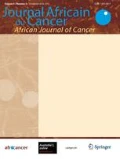Abstract
Breast cancer rates in high-income countries increased sharply with industrialization and urbanization but are now declining. Rates in low-income countries are instead rising after adoption of western type lifestyles. Some breast cancer risk factors are modifiable for prevention while others are not. The purpose of this study was to find out if wearing of brassieres and psychosocial stress had association with breast cancer occurrence. It was conducted from 09/08/11 to 23/12/12. Women with newly diagnosed breast cancer were matched with controls for age. A questionnaire was administered to detail patterns of brassiere wearing and marital stability, and some known breast cancer risk factors which could be confounders. Multivariate statistical models were used to discriminate confounders, and significance calculated at 95% confidence intervals. Three hundred and thirty-nine cases and 355 controls were included. The median age for cases was 48 years, range 25 to 80 years. The median for controls was 49, range 23 to 83 years. Age at onset of menses, parity, and the number of children who breastfed for at least 12 months was similar between cases and controls. There was no difference in level of education (p=0.783), and marital status (p=0.432) between cases and controls. On the other hand intensity of brassiere use (p<0.001), occupation (p<0.001), area of residence (p=0.045) diet (p=<0.01), duration of use of hormonal contraceptives (p<0.001), and family history of breast cancer (p=0.016), had association with breast cancer occurrence.
Similar content being viewed by others
References
Korir AR, Okerosi N, Parkin DM (2008). Nairobi Cancer Registry 2004–2008, May 2014.
Parkin DM, Pisani P, Ferlay J (1999) Global cancer statistics. GA Cancer J Clin 49:33
Key TJ, Verkasalo PK, Banks E, et al (2001) Epidemiology of breast cancer. Lancet Oncol 2:133
Lynch HT, Lynch JF (1986) Breast cancer genetics in an oncology clinic: 328 consecutive patients. Cancer Genet Cytogenet 22:369
Claus EB, Schildkraut JM, Thompson WD, et al (1996) The genetic attributable risk of breast and ovarian cancer. Cancer 77:2318
Whittemore AS (1997) Risk of breast cancer in carriers of BRCA gene mutations. N Engl J Med 337:788.
ACIM (Australian Cancer Incidence and Mortality) Books (2007). Canberra: Australian Institute of Health and Welfare (AIHW), 2007 4/9/2007
Othieno-Abinya NA, Nyabola LO, Abwao HO, and Ndege PK (2002) Post-surgical management of patients with breast cancer at Kenyatta National Hospital. East Afr Med J 79:46–52
Borresen-Dale AL (2003) TP53 and breast cancer. Hum Mutat 21:292–300
Singer S, Grismaijer S. Dressed to kill (1995) The link between breast cancer and bras. New York Avery
Willett W, Rockhill B, Hankinson S, et al (2004) Epidemiology and nongenetic causes of breast cancer. IN: Harris J eds. Diseases of the breast. Philadelphia: Lippincott Williams and Wilkins
Boyd NF, Stone J, Vogt KN, et al (2003) Dietary fat and breast cancer risk revisited: a meta-analysis of the published literature. Br J Cancer 89:1672–85
Meijers-Heijboer H, van den Ouweland A, Klijn J, et al (2002). Low penetrance susceptibility to breast cancer due to CHEK2(*) 1100delC in noncarriers of BRCA1 or BRCA2 mutations. Nat Genet 31:55–9
CHEK2(*)1100delC and susceptibility to breast cancer (2004) A collaborative analysis involving 10,860 breast cancer cases and 9,065 controls from 10 studies. Am J Hum Genet 74:1175–82
Morley J, Benton D, Solomon G. The role of stress and opioids as regulators of the immune system. In:McCubbin J, Kaufman P, Nemeroff C, eds. Stress, neuropeptides and systemic disease. San Diego: Academic Press 1991
Rabin BS, Cohen S, Ganguli R, Lysle DT, Cunnick JE (1989). Bidirectional interaction between the central nervous system and the immune system. Crit Rev Immunol 9:279–312
Butow PN, Hiller JE, Price MA, et al (2000). Epidemiological evidence for a relationship between life events, coping style, and personality factors in the development of breast cancer. J Psychosom Res 49:169–81
Butow P, Hiller J, Thackway S, Kricker A (1997). Psychosocial factors and the risk of developing breast cancer. Woolloomooloo (NSW): NHMRC National Breast Cancer Centre
Duijts SF, Zeegers MP, Borne BV (2003). The association between stressful life events and breast cancer risk: a meta-analysis. Int J Cancer 107:1023–9
Breast cancer and hormonal contraceptives (1996) Collaborative analysis of individual data on 53,297 women with breast cancer and 100,239 women without breast cancer from 54 epidemiological studies. Collaborative group on hormonal factors in breast cancer. Lancet 347:1713–27
Newman B. (2000) Inherited genetic susceptibility and breast cancer. In:Goldman M, Hatch M, eds. Women and health. California: Acad Press, 2000.In
Marchbanks PA, McDonald JA, Wilson HG, et al (2000). Oral contraceptives and the risk of breast cancer. N Engl J Med 346:2025–32.
Hannaford PC, Selvaraj S, Elliott AM, et al (2007). Cancer risk among users of oral contraceptives. Cohort data from Royal College of General Practitioners’ oral contraception study. BMJ 335:651
Author information
Authors and Affiliations
Corresponding author
About this article
Cite this article
Othieno-Abinya, N.A., Wanzala, P., Omollo, R. et al. Comparative study of breast cancer risk factors at Kenyatta National Hospital and the Nairobi Hospital. J Afr Cancer 7, 41–46 (2015). https://doi.org/10.1007/s12558-014-0358-1
Received:
Accepted:
Published:
Issue Date:
DOI: https://doi.org/10.1007/s12558-014-0358-1


